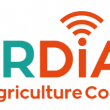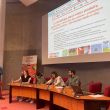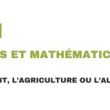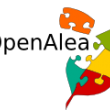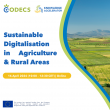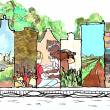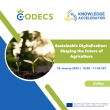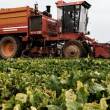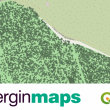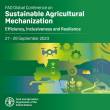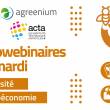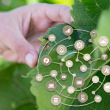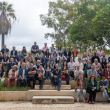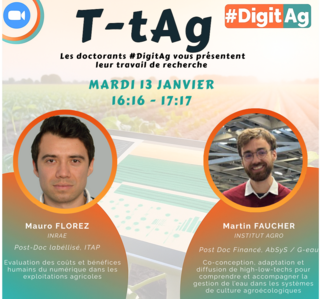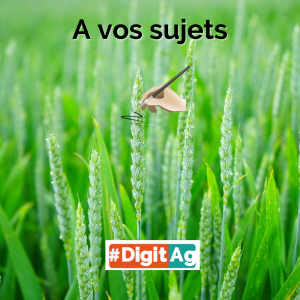-
[hal-04506794] Optimal structures of crop irrigation strategies with state constraints
We investigate an optimal control problem of crop irrigation with non-autonomous and non-smooth dynamics. Depending on contexts and objectives, several formulations associated to different constraints and criteria can be derived. Our work aims at providing optimal feedback solutions for these problems by deriving and analyzing the optimality necessary conditions. To this end, we assemble the different problems into a common formulation, and we carry out a dedicated way of handling state constraints. We show that all optimal irrigation strategies belong to a family of simple parameterized time-varying feedback controls, independently of the context and objective, and suitable for computational purposes.
ano.nymous@ccsd.cnrs.fr.invalid (Ruben Chenevat) 28 Mar 2025
https://hal.science/hal-04506794v2
-
[tel-05426346] Transition numérique et mise en œuvre de l’agroécologie : une analyse du rôle des coopératives vitivinicoles et de fruits et légumes
La digitalisation est aujourd’hui perçue comme un levier de transformation durable des systèmes agricoles et alimentaires, et de renforcement des dynamiques agroécologiques. Cependant, elle suscite encore des controverses dans la littérature, notamment sur les questions d’adoption et d’usages effectifs des outils numériques en agriculture, mais aussi sur son lien avec l’agroécologie. Ce travail de recherche analyse le rôle des coopératives dans la transition numérique de l’agriculture dans une perspective de mise en œuvre de l’agroécologie. Il vise d’une part, à comprendre les mécanismes de diffusion des outils numériques en agriculture à travers l’analyse du rôle des coopératives en tant qu’intermédiaires, d’autre part, à examiner le lien entre digitalisation et agroécologie, ainsi que le rôle des coopératives dans l’articulation de ces deux dynamiques afin de parvenir à une transformation durable de l’agriculture. Sur le plan théorique, cette recherche mobilise les travaux sur les intermédiaires d’innovation pour comprendre le rôle des coopératives dans le processus de digitalisation de l’agriculture. Cette approche s’articule avec la littérature sur l’adoption des technologies, combinant le modèle UTAUT et le cadre TOE, afin d’expliquer le comportement d’adoption des agriculteurs vis-à-vis des outils numériques et analyser comment ces outils sont mobilisés dans la mise en œuvre des pratiques agroécologiques à travers leurs usages. D’un point de vue méthodologique, cette thèse étudie le cas des coopératives vitivinicoles et de fruits et légumes localisées principalement dans la région Occitanie. Elle repose sur 44 entretiens individuels semi- directifs, dont 20 entretiens réalisés auprès de dirigeants et d’agents techniques de coopérative, et 24 auprès d’agriculteurs coopérateurs. Les entretiens ont été analysés à partir d’une méthode d’analyse de contenu thématique, complétée par une classification ascendante hiérarchique (CAH) sur de l’ACM. Nos résultats révèlent que les coopératives agissent effectivement comme des intermédiaires de la transition numérique, en assurant des fonctions d’intermédiation de connaissances (ou cognitives) et d’innovation numérique pour favoriser la diffusion et l’adoption des outils numériques auprès des agriculteurs et accompagner les usages. Les analyses des entretiens auprès des agriculteurs permettent d’identifier les freins et les motivations à cette adoption. En outre, ces analyses montrent que le lien entre la digitalisation et l’agroécologie reste à ce stade peu perceptible, car la majorité des offres d’outils numériques est jusqu’ici destinée à la mise en œuvre d’une agroécologie « faible » impliquant des changements mineurs et moins profonds dans les pratiques agricoles. Ce travail met également en relief l’éventuel rôle d’arbitrage des coopératives dans la mise en œuvre des transitions numérique et agroécologique pour une agriculture durable. Cette thèse contribue à mettre en lumière le rôle central des organisations intermédiaires, notamment des coopératives, dans le développement et la mise en œuvre des transitions numérique et agroécologique, tout en relevant l’émergence de nouvelles fonctions et stratégies d’intermédiation associées. Elle invite également à porter un regard réflexif sur les mécanismes de gouvernance coopérative dans l’étude des processus d’innovation au sein des coopératives.
ano.nymous@ccsd.cnrs.fr.invalid (Békanty Ange Kouassi) 19 Dec 2025
https://hal.inrae.fr/tel-05426346v1
-
[hal-05214356] Comparing the impact of weather forecasts, observation and parameterization uncertainties when predicting water stress in vineyards
We analyze the impact of different uncertainty sources when using of a crop water stress model with weather forecasts in order to make crop water stress predictions. Three uncertainty sources are jointly studied: (i) the observation uncertainty, coming from the use of past weather data not directly located on the field under study, (ii) the input uncertainty, coming from imperfect values of critical crop model parameters, (iii) the forecast uncertainty coming from the difficulty to predict future weather data. These three uncertainty sources are modeled and their impact characterized using a dedicated double-stage sensitivity analysis that allows to tackle two issues: dependencies among input factors and multivariate outputs. The analysis is performed on a large database of 12000 scenarios covering 5 years of weather data observations and forecasts from Integrated Forecast System Ensemble Prediction System (IFS-EPS) associated to 10 different locations in France and various simulated soil conditions. The results show that all uncertainty sources matter, but not in the same ranking depending on lead time. In particular, forecast uncertainty becomes in average the dominant source from the 5th day of forecast, accounting for 64% of the variability at a 7-day lead and 86% at a 15-day lead. Our analysis also highlights the existence of several interpretable dynamic patterns of uncertainty dominance, where each of the two other uncertainty sources (past weather data and cropping system parameterization) can dominate the overall uncertainty for some specific part of the forecasting period, stressing that no uncertainty source can be a priori neglected.
ano.nymous@ccsd.cnrs.fr.invalid (Bachar Tarraf) 19 Aug 2025
https://hal.inrae.fr/hal-05214356v1
-
[hal-05323445] Robustness of high-throughput prediction of leaf ecophysiological traits using near infrared spectroscopy and poro-fluorometry
Water scarcity is a major threat to crop production and quality. Improving drought tolerance through variety selection requires a deeper understanding of plant ecophysiological responses, but large-scale phenotyping remains a bottleneck. This study assessed the potential of high-throughput tools (spectroscopy and poro-fluorometry) to predict leaf morphological and ecophysiological traits in a grapevine diversity panel grown in pots under well-watered outdoor conditions and under three contrasting soil water treatments in a greenhouse. We found a certain complementarity between measuring devices. Spectrometers could accurately predict leaf mass per area, water content, and water quantity (R² > 0.58), while the poro-fluorometer was efficient for predicting net CO₂ assimilation (R² > 0.72), regardless of the water treatment. The prediction of leaf mass per area using spectrometers appeared to be quite robust across both outdoor and greenhouse experiments, while the prediction of water use efficiency was dependent on the water treatment, with much better predictions under moderate (R² > 0.73) than severe water deficit. Calibrated models were then applied to the full diversity panel using only high-throughput measurements to estimate trait values and their broad-sense heritability. Leaf mass per area, also measured directly, showed similar heritability whether based on observed or predicted data. Heritability estimates for predicted traits reached up to 0.5. Overall, our findings support the use of spectroscopy and poro-fluorometry as reliable, non-destructive tools for high-throughput phenotyping, enabling genetic studies on drought-related traits in grapevine.
ano.nymous@ccsd.cnrs.fr.invalid (Eva Coindre) 21 Oct 2025
https://hal.science/hal-05323445v1
-
[hal-05324268] AgroforestAR: A mobile app for visualizing Agroforestry systems in Augmented Reality
Agroforestry is gaining more and more attention from researchers and practitioners in temperate areas, but it remains a vague concept for most of the public. This is because the renewal of interest for agroforestry systems is quite recent, demonstration sites are rare, and trees are still young, and therefore not very visible. The aim of AgroforestAR is to allow visualizing what an agroforestry system could look like on a given piece of land (including in your garden!). It uses the augmented reality capabilities already available in most smartphones, to superimpose, on the view seen by the phone’s or tablet’s camera, trees aligned along a line defined by the user by walking from one side of the piece of land to the other side. The user can then choose the tree species (among 5 available species currently) and size, as well as different distances between tree lines and different distances between trees along the line. The user can choose between four seasons, which will affect sun elevation, and for deciduous species also canopy leafiness, in order to visualize tree shade projection at different times of day. The app is freely available on Apple (https://eneo.fr/agroforestAR_ios) and Android (https://eneo.fr/agroforestAR_android) app stores. To use it, stand at the bottom-left corner of the plot, open the app, “scan” the ground around you to detect the soil surface, and click on the dotted area where you want to plant the first tree. Then walk to the top-left corner of the plot, and click where you want to plant the last tree in the row. Four rows of trees are automatically placed to your right. Beyond the use as an awareness-raising tool for the public, this app could be used in the future to help farmers decide between several possible options for their agroforestry project. Therefore, in the future, we intend to add the possibility to download more complex agroforestry patterns, using the ESSU concept (Rafflegeau et al. 2023) and combinatorial maps (Lemiere et al. 2023) to represent complex agroforestry systems. Thus, an advisor could design one or several alternative systems, send a download code to the farmer, who could then visualize the different options directly in their own fields. The following step will then to link this tool with prediction models to visualize the production of ecosystem services.
ano.nymous@ccsd.cnrs.fr.invalid (Marie Gosme) 21 Oct 2025
https://hal.inrae.fr/hal-05324268v1
-
[hal-05324035] Les coopératives, intermédiaires de la transition numérique de l’agriculture ?
La digitalisation est perçue comme un levier de transformation durable des systèmes agricoles et alimentaires, et une contribution aux dynamiques agroécologiques. Cependant, elle fait l’objet de nombreuses controverses, notamment sur les questions autour de la connaissance et du déploiement effectif des outils numériques dans les exploitations. Cette contribution examine les mécanismes de diffusion du numérique en agriculture à travers l’intermédiation des coopératives. Plus particulièrement, elle explore dans quelle mesure ces organisations peuvent impulser l’innovation numérique en assurant un rôle d’intermédiaire d’innovation. Cette recherche s’appuie sur 20 entretiens semi-directifs réalisés auprès de dirigeants de coopératives vitivinicoles et de fruits et légumes, principalement localisées en Occitanie (France). L’analyse a permis de révéler un engagement des coopératives à différents stades de la transition numérique de l’agriculture à travers une diversité d’actions et de stratégies d’intermédiation, et d’identifier différents profils d’intermédiaires. Le rôle central des coopératives et des techniciens agricoles dans l’articulation entre la digitalisation et les enjeux agroécologiques est identifié.
ano.nymous@ccsd.cnrs.fr.invalid (Békanty Ange Kouassi) 21 Oct 2025
https://hal.inrae.fr/hal-05324035v1
-
[hal-05353446] Public and private support of the AgriTech : what rationale for what innovation pathway ?
AgriTech are “advanced technological products and services that increase productivity and reduce environmental impact”, according to the website of SummitAgro, a Chilean agricultural inputs company. Similarly, on the website of BPI France, the French public investment bank, we can read that AgriTech start-ups “propose breakthrough innovations and provide more efficient, environmentally-friendly solutions”. We observe positive discourses and a variety of support instruments from both public and private actors, as well as a global increase in the interest of venture capital and private equity in the agrifood sector (Lajoie-O’Malley et al., 2020; Sippel and Dolinga, 2023). This support is legitimized in particular by the “missions” that these technological developments would enable to fulfil, related to the “techno-scientific promise” of AgriTech, such as efficiency, productivity, environmental damage but also working conditions, cooperation or participation (Martin and Schnebelin, 2024). Both private and public organisations support the development of AgriTech, with discourses on “mission-oriented” support. Despite this evolution and the growing influence of private funding on the agricultural innovation system (Glenna et al., 2015), the AgriTech ecosystems, and their impact on the agricultural innovation system, remain poorly studied (Klerkx and Villalobos, 2024). It raises questions about what are the rationales of public and private support for AgriTech development, and how it does or does not promote the “missions” of environmental, economic and social improvement. It has not yet been well investigated whether public and private instruments support AgriTech in the same way or if they have specificities in terms of rationales for action. To address these research gaps, we present a comparative study of AgriTech innovation ecosystems in France and Chile. These two countries offer different settings in terms of institutional context, while both are very dynamic in terms of AgriTech development. In France, the development of the AgriTech sector and its start-ups has been a public policy objective for almost a decade, with discourses on the missions that this technological development will fulfill (Bournigal et al., 2015). Chile has been among the first countries in Latin America to have a dedicated public program for generic start-up support (StartUp Chile - Gonzalez-Uribe and Leatherbee, 2018). More recently, it has been identified as a favourable and attractive area for the development of agricultural technologies (Radiografía Agtech -Endeavor, 2022), and an ecosystem of innovation focused on AgriTech is emerging, driven by public support for innovation and the regrouping of sectoral companies, such as the creation, of AgroTech Chile. Through an analysis of the CrunchBase database we describe the landscape of AgriTech funding. This is complemented with analysis of interviews with key public and private stakeholders of AgriTech innovation ecosystems, to describe the rationale of AgriTech support instruments and who and what they support, through their perceived benefits or their assessment (Kerr et al., 2017). We characterize these instruments according to the organisations providing the support, its objectives, the organisations that can benefit from the support, the type of resources it provides or facilitates access to, and the stage of intervention (Audretsch et al., 2020). The results will allow us to discuss the articulation of private and public support for agricultural innovation, the evolution of agricultural innovation policies in a context of neoliberalism and of a regime of entrepreneurial innovation (« the Silicon Valley model of innovation »).
ano.nymous@ccsd.cnrs.fr.invalid (Éléonore Schnebelin) 07 Nov 2025
https://hal.inrae.fr/hal-05353446v1
-
[hal-05256477] Holding Experts Together?
Contemporary socio-technical challenges such as digital transformation and climate change demand collaboration across diverse professional knowledge domains, including academic, technical, and policy-oriented fields. While interdisciplinary and transdisciplinary approaches have long sought to integrate different forms of knowledge, their effectiveness remains uneven. This panel introduces interexpertise as a novel framework for rethinking collaboration, moving beyond conventional notions of expertise as academic, hierarchical and exclusive. Instead, interexpertise conceptualizes professional knowledge more broadly, encompassing distinct yet interdependent forms of specialized traditions and problem-solving approaches (Abbott).Building on interdisciplinarity (Barry & Born) and transdisciplinarity (Dedeurwaerdere), interexpertise shifts the focus from integration to negotiated authority, recognizing that consensus is neither always achievable nor desirable. It engages with STS — notably trading zones (Galison), boundary objects (Star & Griesemer), and boundary work (Gieryn) — while also drawing from the sociology of professions and organizational science. By foregrounding professional expertise beyond academia, this framework interrogates continuity in entrenched knowledge hierarchies, change in expertise negotiation processes, and critique of dominant models of collaboration.Through theoretical analysis and empirical cases in fields such as digital agriculture, environmental governance, and education, the panel explores how reframing collaboration as interexpertise reconfigures epistemic hierarchies and fosters both co-creation and conflict-resilient collaboration. Case studies will highlight procedural tools such as reflexive negotiation protocols and co-design frameworks that promote inclusive and context-sensitive knowledge integration. By examining both successful collaborations and enduring tensions, this panel advances STS debates on “holding together” and offers interexpertise as a framework for fostering resilience in complex socio-technical systems.
ano.nymous@ccsd.cnrs.fr.invalid (Jongheon Kim) 15 Sep 2025
https://hal.science/hal-05256477v1
-
[lirmm-05251082] Empowering Relational Concept Analysis Using Large Language Model Knowledge Delivery
Relational concept analysis (RCA) computes and represents relational datasets as lattices of concepts and implications. This approach relies on the computation of relational attributes which capture quantified relationships between objects and concepts. However, interpreting this representation is challenging for end-users. FCA experts must combine relational attributes from different concept lattices to obtain a complete formulation, while domain experts (e.g., software engineers, agronomists) face the additional difficulty of extracting meaning from these mathematical structures. This paper proposes an approach to address this issue by leveraging Large Language Models (LLMs). It comprises two main components: (1) the generation of a textual description of relational attributes; (2) the design of a generic prompt that enables LLM to produce a natural-language description of RCA artifacts using the generated textual description. The approach is illustrated using representative implications from a real-world agroecological dataset.
ano.nymous@ccsd.cnrs.fr.invalid (Alain Gutierrez) 12 Sep 2025
https://hal-lirmm.ccsd.cnrs.fr/lirmm-05251082v1
-
[hal-05240478] OccitAnum, an archipelago living-lab to evaluate and co-design digital technologies as enablers of the agroecological transition
[...]
ano.nymous@ccsd.cnrs.fr.invalid (Jacques-Eric Bergez) 04 Sep 2025
https://hal.inrae.fr/hal-05240478v1
-
[hal-05223516] Retrieving total transpirable soil water in a rainfed vineyard using vine shoot growth, weather, and Sentinel-2 data
Winegrowers must regulate grapevine water status, as it significantly influences plant vigor, yield, wine aroma, and ultimately the market value of the final product. Total Transpirable Soil Water (TTSW)-the maximum water available for grapevine extraction-plays a critical role in vineyard water management. However, direct measurement of TTSW is operationally challenging, lacks spatial representativeness, and is especially complex for deep-rooted, rainfed vineyards, which dominate Mediterranean regions. This study proposes a low-cost, scalable methodology for TTSW estimation, adapting an Inverse Modeling approach to incorporate accessible data sources: vine shoot growth indices based on simple visual observations, weather data, and Sentinel-2 imagery. The adapted model was evaluated in a rainfed vineyard in Southern France across six vine plots, achieving a mean absolute error of 30 mm compared to benchmark methods. Given the TTSW range, this error is considered acceptable. The method performed best in plots without dead or missing vines and required less than one hour of fieldwork per plot, offering substantial operational advantages over traditional soil profile analysis. Additionally, the method demonstrated lower estimation uncertainty than the traditional soil-based benchmark. This study highlights the potential of integrating TTSW inverse modeling with accessible data sources, particularly vine shoot growth indices, to develop a cost-effective and scalable protocol for TTSW estimation in rainfed vineyards. These findings address a critical gap in water management knowledge for non-irrigated vineyards and offer practical benefits for winegrowers in water-scarce regions.
ano.nymous@ccsd.cnrs.fr.invalid (Yulin Zhang) 26 Aug 2025
https://hal.inrae.fr/hal-05223516v1
-
[hal-05034379] Fruitlet Core Rot disease in ‘Queen Victoria’ pineapple infructescence triggers local and systemic metabolome reconfigurations
Highlights: • Profiling of primary and secondary metabolites in pineapple due to FCR infection. • Highlighting of FCR-induced variations in major amino acids and carbohydrates. • Identification of phenolics implicated in pineapple defense mechanism following FCR. • Uncovering of a systemic response to the FCR infection in pineapple fruit. Abstract: We studied the metabolomes of 'Queen Victoria' pineapples subjected to the fungi-induced fruitlet core rot (FCR) disease, a major quality issue in the pineapple industry. Analyses were carried out on the pulp and skin of individual fruitlets within healthy or black spotted infructescences, in order to profile three types of samples: healthy, infected and asymptomatic fruitlets. Our results reveal distinct responses to FCR in pulp and skin of infected fruitlets, both quantitatively and qualitatively. The pulp displayed much stronger and diverse changes, including the implementation of a local phenolic-based defense reflecting both antimicrobial activity and cell wall turnover. Evidence of strong redox regulation linked to the presence of the pathogen was observed through variations in proline and glutathione-conjugated compounds. Moreover, among the numerous sugar variations, a particular trehalose pattern emerged as an antagonistic issue between the plant and the fungus. The activation of signaling pathways following the fungal attack was also revealed, with the accumulation of pipecolate and alphaaminobutyrate, involved in defense priming and systemic acquired resistance. Interestingly, we also found significant metabolic changes in asymptomatic fruitlets, similar in nature but smaller in magnitude, demonstrating the existence of a systemic response to infection. This work opens the way to a better understanding of the infection and defense mechanisms involved in FCR and their consequences on organoleptic quality.
ano.nymous@ccsd.cnrs.fr.invalid (Lorraine Latchoumane) 15 Apr 2025
https://hal.inrae.fr/hal-05034379v1
-
[hal-05199121] About drivers of performance for crop growth model calibration at the within-field scale
The calibration process is a necessary step to improve crop growth model (CGM) performances and to reduce the uncertainty related to model parameters. Modeling agronomic variables at the within-field scale needs to accurately reproduce the spatial pattern to enable a suitable spatial management. Spatial calibration is one efficient downscaling method for CGM spatialization. The objective of this study is to better understand the drivers of performance of spatial calibration by comparing it to an aspatial calibration (i.e. at field or site-specific scale) in various conditions. The impact of three driving properties was studied: the targeted variable variance, its level of spatial structure, and the correlation level of ancillary data. To this aim, a method was designed to simulate various spatial structures from the one of an existing vineyard whilst ensuring the temporal consistency of the simulated data. The method was applied to a vineyard CGM (WaLIS) aiming at estimating plant water restriction using predawn leaf water potential (Ψ PD ) measurements. Results showed that spatial calibration improved the model performances at the within-field scale when Ψ PD was strongly structured and highly correlated to the ancillary data. When Ψ PD was either moderately or weakly spatially structured, the spatial constraint added more error instead of correcting errors, deteriorating the CGM performances. The ancillary data and the segmentation algorithm had a large impact on the spatial calibration performances.
ano.nymous@ccsd.cnrs.fr.invalid (Daniel Pasquel) 04 Aug 2025
https://hal.inrae.fr/hal-05199121v1
-
[hal-05155592] Differences in growth features between species are driving cereal-legume intercrop yield: A statistical learning approach based on aggregated dataset
Increasing crop diversification is crucial for developing more sustainable agricultural systems, and cereal-legume intercropping is a promising strategy. This study investigates the factors influencing the yield of cereal-legume intercrops using data from six field experiments in southwestern France, where durum wheat was intercropped with either faba bean or pea. We assessed how differences in plant traits (e.g., height or biomass growth rates) between the associated species were related to the intercrop productivity. Additionally, we developed a novel modeling approach, combining machine learning and mixed-effects models, to identify the key drivers of intercrop performance based on variable importance. Our results showed that interspecific differences in plant traits within intercrops, particularly in biomass accumulation rate, maximum leaf area index, and elongation rates, were the most important factors explaining intercrop yield. These traits and their differences mainly suggest that competitive processes shape the outcome of a mixture and highlight the importance of dynamic measurements in agronomic experiments. The relationship between species yield and trait differences was symmetric for both intercropped species. Furthermore, these relationships were scale-dependent, with trends observed at the aggregate level not always consistent at the level of individual experiments. Our study highlights the importance of considering trade-offs when designing intercropping systems for practical applications and demonstrates the value of combining machine learning with ecological knowledge to gain insights into complex agricultural systems from aggregated datasets.
ano.nymous@ccsd.cnrs.fr.invalid (Rémi Mahmoud) 10 Jul 2025
https://hal.science/hal-05155592v1
-
[tel-05189337] Interactions entre les attaques de ravageurs et la croissance des plantes à l'aide d'une approche par modélisation appliquée au café robusta en Ouganda. Effets sur la production.
Anticiper les rendements agricoles exige une meilleure compréhension de l’impact à long terme des ravageurs et maladies sur la croissance et la productivité des plantes. Cette thèse propose une approche de modélisation intégrant à la fois la dynamique des bioagresseurs, le développement des plantes et leurs interactions, tout en limitant la complexité de la modélisation. Un cadre de couplage basé sur la métaprogrammation a été conçu pour articuler différents modèles sans modifier en profondeur leur structure. L’approche repose sur une une structure de médiation entre modèles. L’étude s’appuie sur le cas du caféier robusta en Ouganda, fortement exposé à plusieurs ravageurs (notamment le Coffee Berry Borer, le Black Coffee Twig Borer et la Red Blister Disease). Un modèle de croissance du caféier, fondé sur le formalisme GreenLab, simule la structure, le fonctionnement et l’état sanitaire de la plante, en intégrant les effets des agressions sur son développement. En parallèle, un modèle de bioagresseurs a été développé, permettant de décrire leur cycle de vie et leur réponse aux facteurs biotiques et abiotiques dans une architecture modulaire adaptable à plusieurs espèces. Les deux modèles utilisent une structuration par cohortes, qui limite la complexité informatique. Les modèles ont été paramétrés à partir de données de la littérature et d’expérimentations spécifiques, puis validés par confrontation aux observations disponibles. Ce cadre permet de simuler des scénarios d’attaque et d’en évaluer les conséquences sur la production. Au-delà du cas du caféier, cette approche offre un outil générique pour analyser les interactions entre plantes et organismes nuisibles. Elle constitue un levier pour améliorer la gestion des cultures dans un contexte de transition agroécologique et de changement climatique.
ano.nymous@ccsd.cnrs.fr.invalid (Houssem E M Triki) 28 Jul 2025
https://hal.inrae.fr/tel-05189337v1
-
[hal-05186885] Les coopératives sont elles vectrices de la transition numérique de l’agriculture ?
Objectif et/ou questions de recherche : Le développement du numérique dans le secteur agricole est perçu par les institutions publiques et internationales comme un levier de production efficace et durable, de renforcement de la sécurité alimentaire (Trendov, 2019), mais aussi de réponse aux défis environnementaux à travers les technologies de l’agriculture de précision et autres modèles numériques (DeLonge et al., 2016). Cependant, les bénéfices attribués à ces outils, suscitent encore des controverses dans les débats scientifiques et professionnels agricoles. Ces réactions soulèvent des questionnements sur la connaissance autour du numérique et son déploiement dans les systèmes agricoles. Dans ce cadre, la littérature met en lumière le rôle central des organisations intermédiaires dans la diffusion des innovations, notamment celui des coopératives agricoles. Au-delà de leur fonction initiale de mutualisation des moyens de production et de commercialisation de leurs membres, celles-ci promeuvent l’innovation auprès des agriculteurs à travers le transfert de technologies et de connaissance, et le conseil (Bidet et Defourny, 2019). Toutefois, leur rôle dans la digitalisation de l’agriculture n’a jusqu’ici fait l’objet que de très peu d’études. C’est pourquoi, cette recherche s’intéresse aux coopératives en tant que catalyseurs de la transition numérique de l’agriculture pour des systèmes agricoles plus durables et responsables. Elle vise à comprendre comment, en tant qu’intermédiaires d’innovation, les coopératives peuvent favoriser l’adoption d’innovations numériques dans les systèmes agricoles. Cadre conceptuel : Peu d’études concernent à ce jour les coopératives agricoles, malgré leur rôfle clé dans l’innovation amont (Magrini et al., 2013). Néanmoins, quelques travaux sur les systèmes 2 d’innovation, ont permis de mettre en évidence les rôles des coopératives dans le transfert de la connaissance agricole (Kilelu et al., 2011 ; Yang et al., 2014). Sur le plan théorique, cette recherche mobilise la littérature sur les organisations intermédiaires et les processus d’innovation à partir des travaux de Howells, (2006), qui conçoit un intermédiaire de l’innovation comme « une organisation ou un organisme qui agit en tant qu'agent ou courtier au cours d’un processus d'innovation, en mettant en relation deux ou plusieurs parties ». Méthodologie : D’un point de vue méthodologique, nous examinons le rôle des coopératives françaises dans les filières viticoles, ainsi que fruits et légumes en matière de diffusion des outils numériques destinés à la production agricole. Notre recherche s’appuie sur une démarche de recherche qualitative, et une approche à la fois inductive et abductive. L’étude repose sur 44 entretiens semi-directifs, dont 20 réalisés auprès de dirigeants et d’agents techniques de coopératives et 24 auprès d’agriculteurs associés-coopérateur. Résultats et apports : Les résultats des entretiens indiquent une réelle implication des coopératives dans la transition numérique de l’agriculture. Nos analyses montrent ainsi une évolution du rôle des coopératives vers des fonctions d’intermédiation plus diversifiées. Ainsi, nous avons identifié dans cette recherche dix fonctions et actions d’intermédiation couvrant un très large spectre d’activités. La plupart de ces fonctions correspondent à celles proposées dans la théorie. Toutefois, deux fonctions non mentionnées dans la littérature émergent de notre analyse, à savoir la co- conception et la conception d’outils numériques à l’échelle des coopératives. En outre, il ressort que les actions entreprises par les coopératives pour promouvoir l’adoption du numérique dans les exploitations, semblent être influencées davantage par leur profil et leurs caractéristiques organisationnelles (gouvernance, orientations stratégiques, relation extérieure, taille, filière) que par la nature de l’outil. Par exemple, les coopératives ayant un mode de gouvernance plus participatif, disposant d’un service technique et dont les orientations stratégiques sont axées sur des démarches environnementales et de durabilité, sont plus susceptibles d’assurer des actions favorisant le transfert de connaissance et d’information pour réduire les asymétries d’information, l’établissement de connexion entre les parties en coordonnant leurs interactions, faciliter l’accès au financement. De même, les résultats révèlent que la taille et la filière de production (viticulture ou fruits et légumes) des coopératives peuvent influencer les types d’activités et les moyens qu’elles mettent en œuvre pour encourager l’adoption du numérique. Toutefois, les entretiens avec les agriculteurs soulignent que l’adoption de ces outils n’est effective que grâce à la confiance des agriculteurs envers leur coopérative. Notre recherche met en exergue le rôle central et démultiplicateur des coopératives dans l’adoption du numérique en agriculture, dans une démarche de transformation des pratiques agricoles. Elle souligne aussi la nature disruptive de la digitalisation de l’agriculture, qui nécessite un accompagnement particulier des agriculteurs que les coopératives sont à même de réaliser sous certaines conditions organisationnelles. Ce travail apporte une contribution à la littérature sur le rôle des coopératives en tant qu’organisations intermédiaires et catalyseurs des 3 processus d’innovations numériques. De façon pragmatique, elle met en évidence le place des coopératives agricoles au cœur du développement et du déploiement du numérique dans le secteur agricole. Les politiques publiques pourraient donc s’appuyer davantage sur ces acteurs intermédiaires pour faciliter cette dynamique vers la digitalisation de l’agriculture.
ano.nymous@ccsd.cnrs.fr.invalid (Békanty Ange Kouassi) 25 Jul 2025
https://hal.inrae.fr/hal-05186885v1
-
[hal-05252204] The construction of an interdisciplinary field: The case of digital agriculture in France
This paper investigates whether a strategically organized, regionally focused investment in higher education can accelerate both the promotion of an innovative socio-technological field and the stabilization of its research community. It focuses on a Convergence Institute for Digital Agriculture (DA Institute), launched in 2017 to advance digital agriculture in Montpellier, France. Known for its interdisciplinary approach, the DA Institute united multiple universities and research institutions and funded around 70 doctoral theses, all requiring interdisciplinary collaborations. These efforts aim to foster innovation in digital agriculture, a field that integrates technology with traditional farming practices to address current societal challenges.The study aims to assess whether the DA Institute has successfully shaped digital agriculture into a distinct research field centered in the region and fostered collaborative networks that extend beyond formal co-supervision relationships. Additionally, it explores if this initiative has contributed to establishing a unique identity for digital agriculture, distinct from similar efforts in other countries. Furthermore, the research examines the broader impact of the DA Institute on the scientific landscape and interdisciplinary collaborations in the region, comparing research funded by the DA Institute with independent research projects. The central question is whether this strategic investment has accelerated the development of the field and contributed to a stable research community.To explore these questions, this paper draws on a qualitative documentary analysis of policy documents related to the DA Institute and interviews with participating researchers and PhD students. Additionally, a bibliometric study of publications produced by these researchers will track the evolution of keywords and scientific collaborations. This combination of qualitative and bibliometric approaches will provide a comprehensive evaluation of the effects of the DA Institute's strategic investment on the development of digital agriculture and the construction of a cohesive research community.
ano.nymous@ccsd.cnrs.fr.invalid (Jongheon Kim) 12 Sep 2025
https://hal.inrae.fr/hal-05252204v1
-
[hal-05246386] Text mining methods for automated web data extraction to create a tropical weeds traits database
Weeds are among the most significant biotic reducing factors to crop production, causing major yield losses, particularly in tropical agroecosystems where they benefit from favorable climate conditions. However, the high diversity of tropical weeds (more than 1,700 species observed) is still poorly known, especially from a trait-based perspective. Beyond impeding their identification, this knowledge gap strongly limits our understanding of how they respond to the environment and agricultural practices, which significantly compromises the development of appropriate agroecological management. Currently, quantitative data on tropical weed traits are scarce and often difficult to extract. Moreover, qualitative data are heterogeneous from a semantic, syntactic and structural point of view and come from various sources (e.g., databases or herbarium websites such as TRY, GBIF, Kew Garden, WIKTROP, Seed Information Database) in various formats (e.g., numeric, textual, graphical) making them difficult to access, integrate, analyze and model. Though, there is a need to gather, consolidate and standardize the existing knowledge on tropical weed traits to better understand how biotic and abiotic filters influence their growth, development, and effects on cropping systems performances. Our work aims to create a global trait database dedicated to tropical weeds based on existing online sources. Based on an extensive list of tropical weed species, we use and compare different web scraping and text mining algorithms to collect, sort out, clean and organize relevant qualitative and quantitative data on plant traits in a large sense (i.e. information on plants and organs morphology, growth, physiology, phenology, ecology) from various pre-identified data sources. Using these methods provides access to nonnumerical data (e.g. plant reproduction habits) and allows us to explore “grey literature” to enrich our database. Then, the information gathered is filtered and standardized into a database to enable comparative analyses of species traits. We then address the benefits of our approach in the context of weed science. Drawing on recent data science methods, this work represents a crucial step towards filling in the knowledge gaps concerning these numerous tropical weed species and should help the development of sustainable weed management practices in tropical cropping systems.
ano.nymous@ccsd.cnrs.fr.invalid (Jules Travard) 09 Sep 2025
https://hal.science/hal-05246386v1
-
[hal-05074927] Standardiser les données expérimentales pour faciliter l'innovation dans le domaine des bio solutions : le projet CASDAR STAR
Cet article présente le projet STAR sur la construction d'un standard pour partager les données d'expérimentation agronomique évaluant les biosolutions pour 3 types de cultures : oléagineux, vigne et maraîchage.
ano.nymous@ccsd.cnrs.fr.invalid (Florence Amardeilh) 20 May 2025
https://hal.inrae.fr/hal-05074927v1
-
[hal-05136932] Evaluating a simple method for mapping grapevine parameters in on-farm experimentation
On-Farm Experiments (OFE) help develop farming practices suited to specific conditions by enabling direct experiments on farms. Precision agriculture tools can enhance OFE by mapping crop responses spatially, but cost barriers limit their use in small-scale farms, such as vineyards in Southern France. This study examined a low-cost method for mapping grape harvest yield using tracking devices on existing equipment. Conducted in a 4.7 ha vineyard, the research explored three experiments addressing nitrogen applications, cover crop competition, and agroecological practices. It assessed the technical, spatial and economic feasibility of the methodology, with the aim of improving viticultural practices in a context of agroecological transition.
ano.nymous@ccsd.cnrs.fr.invalid (Basile Ploteau) 30 Jun 2025
https://hal.inrae.fr/hal-05136932v1
-
[hal-05169036] Prédiction des séquences culturales par apprentissage automatique : une comparaison entre grandes cultures et maraîchage diversifié
La rotation des cultures est une pratique consistant à alterner différentes cultures sur une même parcelle pour des bénéfices agronomiques. Cependant, cette pratique est difficile car elle est dépendante de règles agronomiques mais aussi d'une expérience du terrain permettant de connaître les rotations bénéfiques, neutres ou à éviter. Nous proposons une méthodologie d'implémentation de modèle d'apprentissage machine pour la prédiction de séquence de culture basé sur l'historique mais aussi sur le contexte de culture de l'agriculteur.
ano.nymous@ccsd.cnrs.fr.invalid (Baptiste Darnala) 18 Jul 2025
https://hal.science/hal-05169036v1
-
[hal-05166794] MAEVa : Une approche hybride pour la mise en relation des variables expérimentales agroécologiques
Les variables sources ou les propriétés observables utilisées pour décrire les expérimentations agroécologiques sont hétérogènes, non standardisées et multilingues, rendant leur compréhension, explication et utilisation difficiles dans la modélisation des systèmes de culture et les évaluations multicritères de la performance des systèmes agroécologiques. L’annotation des données via un vocabulaire contrôlé, appelé variables candidates de Agroecological Global Information System (AEGIS), constitue une solution. Les mesures de similarité textuelle jouent un rôle clé dans la désambiguïsation du sens des mots, l’appariement de schémas dans les bases de données et l’annotation des données. Les approches courantes incluent (a) la similarité fondée sur les chaînes de caractères, (b) sur le corpus, (c) sur les connaissances et (d) les approches hybrides combinant deux ou plusieurs de ces méthodes. Ce travail propose une approche hybride, Matching Agroecological Experiment Variables (MAEVa), visant à apparier les variables sources et candidates selon (1) l'appariement des noms, (2) celui des descriptions, (3) une combinaison linéaire de (1) et (2), et (4) une méthode de sélection des résultats pour l'évaluation finale. Pour l’appariement des noms, nous étendons BERT-base avec une couche d’attention multi-têtes externe (BERTmha). Pour les descriptions, nous enrichissons celles existantes avec l'API GPT-3.5 Turbo et utilisons TF-IDF pour la représentation vectorielle. Nos résultats montrent que BERTmha améliore la précision de plus de 11% par rapport à BERT-base seul et que notre corpus améliore celle de TF-IDF de plus de 4%. Notre évaluation (étape 4) montre que MAEVa atteint une précision de plus de 66% de $P@1$ à $P@10$.
ano.nymous@ccsd.cnrs.fr.invalid (Oussama Mechhour) 17 Jul 2025
https://hal.science/hal-05166794v1
-
[hal-05136878] The role of On Farm Experimentation (OFE) in the agroecological transition: Results of a workshop in France
[...]
ano.nymous@ccsd.cnrs.fr.invalid (Anice Cheraïet) 30 Jun 2025
https://hal.inrae.fr/hal-05136878v1
-
[hal-05136863] Potential of a Low-Cost Self-Built NDVI Sensor as a Decision-Support tool for managing Cover Crop in Viticulture
[...]
ano.nymous@ccsd.cnrs.fr.invalid (Alexis Bourguignon) 30 Jun 2025
https://hal.inrae.fr/hal-05136863v1
-
[hal-05322111] Évaluation d’une stratégie d’apprentissage associatif dans le but d’améliorer l’utilisation des robots de traite en élevage bovins laitiers
Dans le secteur de l’élevage bovin laitier, le recours aux technologies est de plus en plus important, notamment avec l’émergence des robots de traite. Ces technologies posent toutefois des défis d’adaptation aux animaux. Pour s’adapter, les vaches doivent mobiliser leurs capacités cognitives et en particulier leurs capacités d’apprentissage. Le projet COWGNITION vise à évaluer la possibilité de guider une vache vers un automate à l’aide d’un signal sonore ou vibratoire. Cette étude propose une preuve de concept testant la capacité de 10 vaches laitières à répondre à deux tels signaux lors d’une tâche d’apprentissage associatif opérant. Elle explore également le lien entre trait de personnalité et capacité d’apprentissage. Les résultats indiquent que les vaches n’ont pas atteint le critère d’apprentissage attendu. Néanmoins, différentes stratégies comportementales ont pu être identifiées. Les tests de personnalité révèlent une variabilité des réponses face à la nouveauté. Des liens ont été établis entre traits comportementaux et scores de réussite : les individus les plus audacieux ont des scores significativement plus élevés pour les vibrations, tandis que les plus explorateurs ont des scores significativement plus faibles pour les deux stimuli. Ces résultats sont prometteurs mais nécessitent confirmation dans des conditions expérimentales plus contrôlés avec un protocole d’entraînement plus progressif et sur un plus grand effectif.
ano.nymous@ccsd.cnrs.fr.invalid (Laurine Ruffault) 20 Oct 2025
https://hal.inrae.fr/hal-05322111v1
-
[hal-05246200] Forecasting food security in African countries at sub-national scale: A deep learning approach using heterogeneous data
[...]
ano.nymous@ccsd.cnrs.fr.invalid (Roberto Interdonato) 09 Sep 2025
https://hal.science/hal-05246200v1
-
[hal-05162574] Enjeux et risques de la digitalisation agricole : penser l’innovation responsable dans le contexte d’ouverture de processus d’innovation
L’innovation dans l’agriculture numérique, réalisée suivant un processus ouvert, pour améliorer la productivité et le respect de l’environnement, produit cependant diverses implications susceptibles de remettre en question ses bénéfices réels. Une gouvernance plus responsable peut pourtant orienter les trajectoires d’innovation vers une meilleure prise en compte des enjeux sociétaux. La question de recherche développée est ainsi : « comment les processus d’innovation ouverte peuvent-ils devenir responsables ? ». Les résultats d’une étude qualitative exploratoire révèlent que les processus d’innovation dans l’agriculture numérique privilégient les dimensions technologique et commerciale, intégrant des avantages compétitifs et quelquefois les besoins d’acteurs du secteur agricole, ce qui révèle un potentiel pour une innovation responsable. Cependant, pour réaliser pleinement ce potentiel, il est essentiel de considérer l’ensemble des enjeux et risques de la digitalisation agricole, lesquels sont pluridimensionnels et multi-niveaux. Des mesures spécifiques sont proposées pour mieux réorienter les processus d’innovation vers des trajectoires plus responsables.
ano.nymous@ccsd.cnrs.fr.invalid (Boris Biao) 15 Jul 2025
https://hal.inrae.fr/hal-05162574v1
-
[hal-05256306] Training Interdisciplinary PhD Students to Build Interdisciplinary Communities
This paper introduces the Convergence Institute for Digital Agriculture (#DigitAg), a French public higher education and research institute, as an innovative model for cultivating doctoral students' openness to interdisciplinarity and fostering interdisciplinary communities at local and national scales.Despite extensive scholarship on interdisciplinary collaboration (Klein, 2021; Barry & Born 2013), existing initiatives have predominantly centered on two domains: collaborations among established scientists and interdisciplinary training in undergraduate education. While institutional reforms have prioritized interdisciplinary teamwork among scientists, and undergraduate programs increasingly integrate cross-disciplinary approaches (e.g., Roby, 2024; Interdisciplinary Education program at Utrecht University), doctoral education remains a critical blind spot. When students reach PhD programs — a critical juncture for shaping their research identities — they often encounter entrenched disciplinary structures that limit cross-field engagement (Boden et al., 2011). The lack of targeted support for doctoral trainees represents a missed opportunity to establish interdisciplinarity early in researchers' careers, particularly given the challenges of institutionalizing interdisciplinary research and gaining academic recognition for it as a legitimate research approach.We argue that interdisciplinary PhD training is a strategic lever for cultivating researchers equipped to navigate complex societal challenges and for building durable interdisciplinary communities, especially given the evolving perception of PhD students as emerging professionals rather than passive learners (Mantai, 2015). DigitAg's operational and governance model demonstrates how this can be achieved within existing academic frameworks, as it explicitly focuses on interdisciplinary PhD training, offering insights for policymakers and institutions seeking to bridge the gap between disciplinary traditions and interdisciplinary imperatives..Established in 2017 in Montpellier, DigitAg aims to advance digital agriculture by integrating technological development with agronomic, social, and ecological expertise (Bellon-Maurel et al., 2023). The institute distinguishes itself by functioning both as a funding body and as a support platform for young researcher networking, organizing its activities through a matrix structure that combines six technological axes with eight interdisciplinary challenges. By requiring that every funded PhD involve co-supervision by at least two researchers from different fields, DigitAg has produced approximately 70 interdisciplinary theses that increasingly integrate diverse disciplines across agronomics, engineering, and social science.This study employs a mixed-methods approach to evaluate DigitAg's role in shaping an interdisciplinary research domain. Qualitative data from interviews with 30 stakeholders provides insights into operational dynamics and collaboration patterns (Leavy, 2014), while scientometric analyses track thematic shifts in digital agriculture research and the influence of DigitAg-funded projects. Our analysis reveals three key contributions: the development of researchers skilled at working across disciplinary boundaries, the catalyzation of durable interdisciplinary networks through co-supervision and collaborative events, and demonstration of how targeted institutional support can foster an interdisciplinary research domain while working within existing academic structures.From a policy perspective, DigitAg offers an adaptable template that proves interdisciplinary training can coexist with disciplinary frameworks. Doctoral candidates, poised at a formative career stage, become cultural bridges between disciplines, bringing fresh insights to research groups that might otherwise remain siloed. The Institute's requirement of interdisciplinary co-supervision distributes the ownership of these projects across multiple labs, thereby weaving a durable web of cross-disciplinary relationships that extends beyond individual thesis projects. This study positions DigitAg as a benchmark for interdisciplinary PhD training, offering a scalable blueprint for academia to reconcile disciplinary depth with interdisciplinary breadth, ultimately fostering a generation of researchers prepared to tackle global challenges through collaborative, interdisciplinary lenses.Barry, A., & Born, G. (Eds.). (2013). Interdisciplinarity: Reconfigurations of the Social and Natural Sciences. Routledge. Bellon-Maurel, V., Piot-Lepetit, I., Lachia, N., & Tisseyre, B. (2023). Digital agriculture in Europe and in France: Which organisations can boost adoption levels? Crop & Pasture Science, 74(6), 573–585.Boden, D., Borrego, M., & Newswander, L. K. (2011). Student socialization in interdisciplinary doctoral education. Higher Education, 62(6), 741–755.Callon, M., Courtial, J.-P., Turner, W. A., & Bauin, S. (1983). From translations to problematic networks: An introduction to co-word analysis. Social Science Information, 22(2), 191–235.Frodeman, R. (Ed.). (2017). The Oxford Handbook of Interdisciplinarity (2nd ed.). Oxford University Press.Leavy, P. (Ed.). (2014). The Oxford handbook of qualitative research. Oxford University Press.Louvel, S. (2021). The policies and politics of interdisciplinary research: Nanomedicine in France and in the United States. Routledge.Klein, J. T. (2021). Beyond Interdisciplinarity: Boundary Work, Communication, and Collaboration. Oxford University Press.Mantai, L. (2015). Feeling like a researcher: Experiences of early doctoral students in Australia. Studies in Higher Education, 1–15.Roby, C. (2024). Humanities and Social Sciences in French Engineering Education: A Sociohistory of their Integration in an Apolitical Stance. Engineering Studies, 16(2), 85–107.
ano.nymous@ccsd.cnrs.fr.invalid (Jongheon Kim) 15 Sep 2025
https://hal.science/hal-05256306v1
-
[hal-05121068] What is the best way to communicate the uncertainty of a digital soil mapping product? Some lessons from an end-users survey
Uncertainty in digital soil mapping products is generally quantified and presented alongside the predictions in the form of a second raster map. However, it remains a challenge for end-users to integrate this additional information into their decision-making, and as a result, they tend to ignore uncertainty. The Digital Soil Mapping (DSM) literature has identified two levers for better communicating uncertainty: uncertainty representations that allow users to integrate uncertainty better than with a separate raster map, and spatial aggregation, which consists of representing the spatial information at a coarser resolution to reduce its uncertainty. For the first time in DSM, we involved a large number of end-users (263 people) via a webbased survey to evaluate alternative cartographic representations of soil map uncertainty. Respondents were assigned a decision-making task and asked to select the map that offered the best support, choosing between two maps that displayed the same soil information but differed in how uncertainty was represented and/or in the level of spatial aggregation. The choices made by the respondents as well as the comments they left at the end of the study provided a large dataset from which we could identify factors driving their preferences. We demonstrate that end-users strongly prefer uncertainty to be shown on a separate map, and also favor moderately aggregated maps. Our results question the conventional representation of soil data using highresolution and high-uncertainty maps. We hope that this work will be valuable to scientists in soil science, as well as in other environmental mapping communities, such as ecosystem services and biodiversity, and help them more effectively communicate uncertainty to their end-users.
ano.nymous@ccsd.cnrs.fr.invalid (Léa Courteille) 19 Jun 2025
https://hal.inrae.fr/hal-05121068v1
-
[hal-05094589] Digitainability – une convergence entre numérique et pratiques agricoles durables est-elle possible ?
[...]
ano.nymous@ccsd.cnrs.fr.invalid (Isabelle Piot-Lepetit) 03 Jun 2025
https://hal.inrae.fr/hal-05094589v1
-
[hal-05117250] The Survival of food platforms: The crucial role of alliance strategies in supply control for french platforms
This research focuses on the survival of a new actor in food systems: e-commerce platforms. They are confronted with the instability of supply by farmers. We mobilize the theory of resource dependence to understand what strategies they use to cope with this uncertainty. To this end, we conduct a survey of 103 platforms in France, a country where food e-commerce is well developed. Our results show that the platforms with the best survival rate are those that have reached a sufficient size and that manage their relationships with farmers in the form of an alliance, while controlling the quantity and quality of supply.
ano.nymous@ccsd.cnrs.fr.invalid (Romane Guillot) 17 Jun 2025
https://hal.science/hal-05117250v1
-
[hal-05384543] Agro-STAY: Data collection and analysis of alternative agriculture practices from YouTube
To address the current crises (climatic, social, economic), the self-sufficiency - a set of practices that combine energy sobriety, self-production of food and energy, and self-construction - arouses an increasing interest. The CNRS STAY project (Savoirs Techniques pour l'Auto-suffisance sur YouTube) explores this topic by analyzing techniques shared on YouTube. We present Agro-STAY, a platform designed for the collection, processing, querying and visualization of data from YouTube videos and their comments. We propose a full methodology dedicated to processing YouTube videos, and apply Natural Language Processing (NLP) techniques and language models, which enable a fine-grained analysis of alternative agricultural practices described online. In addition, we provide a well-adapted graphical user interface to help the experts analyzing the extracted knowledge.
ano.nymous@ccsd.cnrs.fr.invalid (Laura Maxim) 27 Nov 2025
https://hal.science/hal-05384543v1
-
[hal-05392364] Adapting BERT and AgriBERT for Agroecology: A Small-Corpus Pretraining Approach
Source variables, or observable properties, used to describe agroecological experiments are often heterogeneous, non-standardized, and multilingual, making them challenging to understand, explain, and utilize in cropping system modeling and multicriteria evaluations of agroecological system performance. A potential solution is data annotation via a controlled vocabulary, known as candidate variables, from the Agroecological Global Information System (AEGIS). However, matching source and candidate variables via their textual descriptions remains a challenging task in agroecology. Domain-general language models, such as BERT, often struggle with domain-specific tasks due to their general-purpose training data. In the literature, these models are adapted to specialized domains through further pretraining, pretraining from scratch, and/or fine-tuning on downstream tasks. However, pretraining a domain-general model on a domain-specific corpus is resource-intensive, requiring substantial time, energy, and computational resources. To the best of our knowledge, no study has further pretrained a domain-general model on a small corpus (less than 100 MB) to adapt it to a domain-specific task and evaluated it on downstream tasks without fine-tuning. To address these shortcomings, this paper proposes further pretraining BERT and AgriBERT on a small agroecology-related corpus. This approach is designed to be both time- and resource-efficient while enhancing domain adaptation. We evaluate the pretrained models on the task of matching source and candidate variable descriptions without fine-tuning. Our results show that our further pretrained AgriBERT (+ Experts + Core) model outperforms all others by more than 8% from P@1 to P@10. These findings showed that small-scale pretraining can significantly improve performance on domain-specific tasks without requiring fine-tuning.
ano.nymous@ccsd.cnrs.fr.invalid (Oussama Mechhour) 02 Dec 2025
https://hal.inrae.fr/hal-05392364v1
-
[hal-05246352] Adapting BERT and AgriBERT for agroecology: A small-corpus pretraining approach
Source variables, or observable properties, used to describe agroecological experiments are often heterogeneous, non-standardized, and multilingual, making them challenging to understand, explain, and utilize in cropping system modeling and multicriteria evaluations of agroecological system performance. A potential solution is data annotation via a controlled vocabulary, known as candidate variables, from the Agroecological Global Information System (AEGIS). However, matching source and candidate variables via their textual descriptions remains a challenging task in agroecology. Domain-general language models, such as BERT, often struggle with domain-specific tasks due to their general-purpose training data. In the literature, these models are adapted to specialized domains through further pretraining, pretraining from scratch, and/or fine-tuning on downstream tasks. However, pretraining a domain-general model on a domain-specific corpus is resource-intensive, requiring substantial time, energy, and computational resources. To the best of our knowledge, no study has further pretrained a domain-general model on a small corpus (less than 100 MB) to adapt it to a domain-specific task and evaluated it on downstream tasks without fine-tuning. To address these shortcomings, this paper proposes further pretraining BERT and AgriBERT on a small agroecology-related corpus. This approach is designed to be both time- and resource-efficient while enhancing domain adaptation. We evaluate the pretrained models on the task of matching source and candidate variable descriptions without fine-tuning. Our results show that our further pretrained AgriBERT (+ Experts + Core) model outperforms all others by more than 8% from P@1 to P@10. These findings showed that small-scale pretraining can significantly improve performance on domain-specific tasks without requiring fine-tuning.
ano.nymous@ccsd.cnrs.fr.invalid (Oussama Mechhour) 09 Sep 2025
https://hal.science/hal-05246352v1
-
[hal-04925931] Impact of farming practices on soil microbial biomass: An international synthesis
Agricultural intensification during the 20th century has profoundly altered soil ecosystems, underscoring the urgent need for sustainable practices enhancing soil quality. Soil microbial biomass is a key indicator of soil quality, reflecting both biological and ecosystem resilience. However, existing studies often focus on specific practices or regions, limiting their applicability to diverse farming systems. This study synthesizes data from 280 scientific publications selected through the Web of Science database, covering a wide geographical range, to evaluate the effects of the main agronomic levers, i.e. tillage, fertilization, crop rotation diversity including inter-cropping, and pesticide use on soil microbial biomass. Statistical analyses revealed that soil microbial biomass is generally promoted by organic fertilization (+64 % to +76 %), reduced tillage (+32 % to +41 %) and increased crop diversity (+10 % to +47 %), while mineral fertilization shows more modest effects (+7 % to +35 %). These results comply with the “carrying capacity” and “ecological habitat” concepts for soil microorganisms: farming practices affect soil microbial biomass either directly through resources availability or survival, and indirectly by changing the soil physical and chemical properties, i.e. habitat properties and growth conditions. By integrating findings from this extensive dataset, this work significantly expands the current understandings of how agricultural practices influence soil microbial biomass. It emphasizes the operational potential of soil microbial biomass as a practical, unifying indicator for assessing the impact of farming strategies on soil quality. Moreover, this study provides actionable insights to support sustainable land management and aligns international soil monitoring initiatives, including the European Directive on soil monitoring and resilience and its national implementations.
ano.nymous@ccsd.cnrs.fr.invalid (Laurie Dunn) 03 Feb 2025
https://institut-agro-dijon.hal.science/hal-04925931v1
-
[hal-05041681] Exploring the optimality of threshold-based crop irrigation feedback strategies
The development of effective crop irrigation strategies is a key element of water management in agriculture, seeking a necessary parsimonious use of resources. Years of practice and accumulation of knowledge have led to numerous irrigation policies, including Threshold-Based Irrigation Strategies (TBIS). This work involves the Controlled Crop Irrigation (CCI) model, a simple dynamical system describing the order-1 biophysical processes at play, for which optimal irrigation policies may be proven and written as TBIS. We aim at studying both the optimal TBIS and their sub-optimal declensions, to identify the most influential parameters (which dictate the structure of optimal irrigation scenarios) but also the effects of errors made on their determination. Much attention is therefore drawn to the crucial "decision time" at which the irrigator decides to increase soil water content from an initial "stress tolerance level" to a "maximal biomass production" setpoint. In this study, we couple known results from optimal control theory and numerical methods for sensitivity analysis and global model exploration. The most striking results are that the optimal decision time is mostly driven by plant growth dynamics and the correct evaluation of stress effects on biomass production, as slightly too low soil moisture levels during the productive stage induce significant losses in final biomass. The genericity of the CCI model and the modularity of the methodology offer promising perspectives for various operational contexts.
ano.nymous@ccsd.cnrs.fr.invalid (Ruben Chenevat) 21 Apr 2025
https://hal.science/hal-05041681v1
-
[hal-05053996] How do farmers manage to take best advantage of semi-natural and wooded pastures in Mediterranean agro-silvo-pastoral systems ?
This study investigates pastoral practices in Mediterranean agro-silvopastoral systems through interviews with 18 small ruminant farmers in southern France. It highlights a wide diversity of grazing strategies shaped by production goals, livestock types, and land characteristics. Farmers who place strong value on grazing adapt their practices seasonally, rely on a broad range of resources (herbaceous and woody), and build their decisions on daily observations of animals and vegetation. The study emphasizes the importance of local ecological knowledge in adaptive rangeland management and its central role in the long-term sustainability of Mediterranean livestock systems.
ano.nymous@ccsd.cnrs.fr.invalid (Elisa Deschamps) 02 May 2025
https://hal.inrae.fr/hal-05053996v1
-
[hal-04959064] Early detection of Zymoseptoria tritici infection on wheat leaves using hyperspectral imaging data
This article presents a hyperspectral imaging (HSI) database of healthy leaves and leaves infected with Zymoseptoria tritici fungal pathogen responsible for leaf blotch (Lb) disease. Leaves of two durum wheat genotypes were studied under controlled conditions to track the evolution of Lb disease and capture significant spectral and spatial differences until the onset of symptoms. Hyperspectral image acquisitions were purchased with two cameras in visible-near infrared (VNIR) and short-wave infrared (SWIR) spectral ranges on eighteen dates between one day before inoculation and twenty days after inoculation. For each wavelength range studied, a total of 1175 images provided information on 3326 leaves measured throughout the experiment. These data are valuable since they can be used as a basis to monitor disease's development over time, to build leaf classification models according to their infection status per genotype per day, to develop prediction models related to symptoms' appearance, or to test imaging and spectral analysis methods.
ano.nymous@ccsd.cnrs.fr.invalid (Lorraine Latchoumane) 11 Mar 2025
https://hal.science/hal-04959064v1
-
[hal-04506042] Le développement du numérique en agriculture : vers une transformation agro-écologique ?
Le développement du numérique est mis en avant comme solution aux enjeux économiques et environnementaux de l’agriculture, alors que ses effets font l’objet de controverses. Cet article cherche à montrer comment le développement du numérique dans le secteur agricole impacte et s’intègre dans les différents modèles agricoles. Pour cela, il propose une approche en économie institutionnelle et multi-niveaux des systèmes d’innovation, mise en oeuvre à travers une méthodologie associant analyses quantitatives et qualitatives. À l’échelle des organisations du système d’innovation agricole, selon que les acteurs se rattachent à l’agriculture biologique ou conventionnelle, les attentes et risques perçus, ainsi que les stratégies de digitalisation, sont différents. Ces différences sont toutefois peu perçues par les acteurs du numérique. A l’échelle des exploitations agricoles, à partir de 98 entretiens avec des agriculteurs, des profils d’usage du numérique sont construits. Dans l’ensemble, les usages du numérique dans les exploitations accompagnent plutôt des stratégies d’écologisation faible, ou symbolique, associées à une trajectoire d’industrialisation, caractérisée par la spécialisation, la concentration, le recours croissant au salariat et à la sous-traitance et l’intégration dans les chaînes de valeur agrialimentaires. Ce travail met en évidence que les perceptions et usages du numérique diffèrent selon les modèles agricoles auxquels les acteurs se rattachent. La digitalisation n’apparaît pas comme la résultante de comportements dits « pionniers » mais dépend de la diversité des modèles et paradigmes, en interaction avec un système socioéconomique qui propose, incite, voire impose ces technologies. La digitalisation actuelle montre plusieurs formes d’oppositions vis-à-vis de la transition agroécologique, que ce soit en termes techniques, d’objectif, de raisonnement, de dynamique temporelle mais aussi d’enjeux politiques et sociaux. Des hybridations semblent toutefois possibles dans le cas de formes d’écologisation industrielle, mais aussi à travers une transformation plus globale de la digitalisation elle-même en repensant ses modèles techniques, économiques et politiques.
ano.nymous@ccsd.cnrs.fr.invalid (Éléonore Schnebelin) 15 Mar 2024
https://hal.inrae.fr/hal-04506042v1
-
[hal-05006930] How can digitalisation contribute to sustainability of business models in agri-food value chains? A systematic literature review
The expectations of digital technologies in sustainable agricultural development are considerable. However, applying these technologies in agri-food value chains can have downsides, which are still barely studied. The main objectives of this systematic literature review were to discover the state of the art of the research in the use of digital technologies in business models contributing to sustainability in the agri-food sector, and to make recommendations for future research and management practice. In order to bring concepts together and develop a theoretical framework and advance knowledge, performing a literature review is conducive. Here, the commonly-used PRISMA-method was used to develop a systematic literature review. From this review, an overview of business model innovations, and drivers, benefits and drawbacks of digitalisation in agri-food value chains were distinguished. Key themes found in the literature were the effects of COVID-19 on digitalisation and business resilience, the economic sustainability of business models, and the importance of communication technologies in agri-food value chains. This article recommends for future research and management practice to use a framework that looks through a value co-creation and open innovation perspective to the individual business model level and the interaction between (sustainable) business models in local and global food systems.
ano.nymous@ccsd.cnrs.fr.invalid (Laura Eline Slot) 26 Mar 2025
https://hal.inrae.fr/hal-05006930v1
-
[tel-05022755] Impact of cartographic representation of uncertainty for decision-making : the case of soil quality in land-use planning
Accurate and spatially explicit information is essential for more informed spatial planning decisions. However, this information comes with significant uncertainty which is often poorly communicated. While map producers have primarily focused on quantifying uncertainty, they have largely overlooked end-users' needs and preferences regarding its representation. As a result, users struggle to interpret and incorporate this information into their decision-making, frequently leading to its disregard. In this thesis, we took the example of a soil quality map produced using Digital Soil Mapping techniques, and followed its entire lifecycle, from the initial spatial predictive mapping to its use in land planning decisions. Along the way, we developed and implemented specific methodologies to improve the map from an end-user’s point of view. To improve the relevance of the map for local decision making, we tried to reduce the uncertainty by increasing the size of the soil dataset used to calibrate the DSM model. To improve map integrity, we performed an uncertainty analysis that included not only the mapping errors but also the errors conveyed by the soil quality indicator. To improve the intelligibility of map uncertainty representations, we tested both spatial aggregations of predicted maps using an agglomerative clustering algorithm and an alternative visualisation technique involving a coincident representation of uncertainty using glyphs. Ultimately, we conducted an experiment involving 283 end-users of soil maps using a web-based survey to identify their preferences regarding the representation of uncertain soil quality information, and assess the impact of map features on their decision-making. Our main findings were that 1) increasing the size of the calibration datasets significantly reduced the uncertainties of the DSM products involved in the production of the soil quality map, but resulted in only a moderate reduction in the uncertainty of the final soil quality map, 2) errors affecting the definition of the soil quality indicators made a small but non-negligible contribution to the overall uncertainty of the soil quality map, 3) agglomerative clustering outperformed other spatial aggregation techniques in reducing uncertainty while preserving the representation of fine soil variation, 4) end-users tend to prefer moderately aggregated map products over traditional raster DSM products and uncertainty representations by separate maps over coincident representations, 5) decision-making was significantly hindered when uncertainty values exceeded a given threshold, 6) there were clear differences in the factors influencing decision making depending on whether the decision was to authorise soil sealing or to protect against sealing. The findings of this thesis allowed us to formulate recommendations for soil map production that better accounts for uncertainty. We hope that these recommendations will assist map-makers in meeting end-users' needs, and that it will contribute to a more effective use of environmental maps in policy-making.
ano.nymous@ccsd.cnrs.fr.invalid (Léa Courteille) 12 Jun 2025
https://hal.inrae.fr/tel-05022755v2
-
[hal-05024427] Exploring the Potential of Agent-Based Models for the Problem of Transhumance Path Exits in Sub-Saharan Africa: Chad’s Routes as a Case Study
Path exits for transhumant livestock are a major problem in many Sub-Saharan African countries. These problems contribute to many community conflicts. Several solutions are currently being studied, including dialogues between stakeholders. In this paper, we propose a numerical approach to address the problem. Based on a commonly accepted model of agent movement, we propose a path simulator to estimate and quantify the risk of exiting the path. This enables quantitative estimation of the exit rates of transhumant animals as a function of the geometric properties of the routes. This model is tested on real transhumance routes in Chad to evaluate the risks of exits along these routes. These new data allow us to better understand the geometric properties on real routes and to evaluate them in terms of exit risk, giving new information to this complex problem. Although our approach does not deal with the whole complexity of this problem, it opens the door to field experimentation with geolocation sensors.
ano.nymous@ccsd.cnrs.fr.invalid (Mahamat Abdouna) 08 Apr 2025
https://hal.inrae.fr/hal-05024427v1
-
[hal-04966518] About the Bang-Bang Principle for Controlled Affine Dynamics With Brownian Noise
We revisit the Bang-Bang principle, established for deterministic dynamics with affine control, in a stochastic setting where the dynamics are subject to Brownian motion. We show that such a principle does not generally apply in this context. However, we demonstrate that it does apply under certain conditions with deterministic controls. With stochastic controls, we obtain, under certain conditions, that Mayer's problems with an expectation criterion and a compact control set are equivalent to the same problems with controls taking values in the closed convex hull of the control set. This result is illustrated by a linearized dynamics of the SIR epidemiological model.
ano.nymous@ccsd.cnrs.fr.invalid (Ruben Chenevat) 05 Aug 2025
https://hal.science/hal-04966518v2
-
[hal-04938628] La levée du blé en ligne. Le travail de maintenance des plateformes du financement participatif agricole
[...]
ano.nymous@ccsd.cnrs.fr.invalid (Nadège Ressia) 10 Feb 2025
https://hal.science/hal-04938628v1
-
[hal-04964158] Le numérique en agriculture : des technologies aux applications
Capteurs, modèles prédictifs, réseaux intelligents, robots : ces technologies, issues de l’électronique, de la science des données, de l’informatique et de la robotique, transforment déjà les exploitations agricoles. Que se cache-t-il derrière ces technologies ? Comment sont-elles mises en œuvre dans des solutions numériques disponibles pour les agriculteurs ? Quels bénéfices peut en retirer le monde agricole ? Destiné aux étudiants, enseignants, agriculteurs et conseillers, ce guide propose une approche structurée et pédagogique sur le sujet. Une présentation claire de 23 technologies essentielles et de leurs applications concrètes dans différentes filières agricoles est proposée. Des planches illustratives proposent également une mise en œuvre de l’ensemble de ces technologies à l’échelle de l’exploitation. Pour aller plus loin, chaque chapitre propose des ressources complémentaires accessibles en ligne. Cette transformation digitale n’étant pas sans ouvrir de nouveaux débats, des pistes de réflexion sont proposées en fin d’ouvrage afin d’accompagner les lecteurs dans l’appropriation du numérique pour construire une agriculture performante, durable et résiliente face aux enjeux du XXIe siècle.
ano.nymous@ccsd.cnrs.fr.invalid (François Brun) 24 Feb 2025
https://hal.science/hal-04964158v1
-
[hal-04867701] Identifying maize architectural ideotypes through 3D structural model validated in the field: Assessing the impact of plant architecture and sowing pattern to improve canopy light regime
[...]
ano.nymous@ccsd.cnrs.fr.invalid (Mario Serouart) 06 Jan 2025
https://hal.science/hal-04867701v1
-
[tel-05009250] Entre communs et « faire commun » : Les communautés rurales de l’Altiplano bolivien central face aux multiples crises qui les affectent
L'Altiplano, situé à environ 3800 m d’altitude entre le Pérou et la Bolivie, est une région où l'agriculture de subsistance et l'élevage sont essentiels pour les familles rurales. La croissance démographique et le morcellement des terres obligent toutefois de nombreux ménages à diversifier leurs activités pour compléter leurs revenus. La région subit une crise environnementale, exacerbée par le changement climatique et les activités anthropiques comme l’intensification agricole, l’industrie minière et l’urbanisation. Ces pressions, combinées à un manque de ressources et d'opportunités, incitent les populations rurales à migrer de façon pendulaire, saisonnière ou permanente vers les villes, les centres miniers ou l’étranger. La complexité du contexte justifie la mise en place d’une démarche inductive, pluridisciplinaire et participative. Notre question de recherche est ainsi née d’une première confrontation au terrain : « Comment les communautés rurales de l’Altiplano central gouvernent-elles leurs communs pour faire face aux multiples crises qui les affectent ? ». Afin d’y répondre, deux communautés autogouvernées reconnues “Territoires Indigènes Originaires et Paysans” sont étudiées de façon comparative. Pour parvenir à cette question, la faire évoluer et y répondre, nous nous sommes appuyés sur une analyse de la littérature ainsi que des données produites par des ateliers participatifs mobilisant des jeux de rôles et des enquêtes de terrain. Un premier jeu (Sumak Kawsay I) a été coconçu avec une méthode innovante s’appuyant sur les « surprises » pour réaliser un diagnostic et mieux comprendre les défis auxquels sont confrontés les agriculteurs et éleveurs. Sumak Kawsay I a ensuite servi de base pour élaborer un second jeu afin d’étudier l’évolution de la gouvernance de la terre (foncier et ressource fourragère) et de l’eau d’irrigation dans un contexte de sécheresse simulée. Sumak Kawsay II s’est focalisé sur la renégociation des règles d’accès de ces potentiels communs, ainsi qu’aux types de solutions mises en place ou à développer, individuelles ou collectives, pour faire face à cette crise. Ce jeu a également facilité la compréhension des principes de justice qui sous-tendent les règles d’accès à l’eau d’irrigation. L’analyse des données d’enquêtes de terrain, qui font partie intégrante de la démarche de modélisation d’accompagnement, ont également donné lieu à des résultats significatifs. Nous caractérisons tout d’abord la gouvernance de la terre et de l’eau d’irrigation dans les deux communautés étudiées et évaluons sa durabilité à l’aide des principes directeurs d’Ostrom (1990). Nous nous penchons ensuite sur les modes d’accès à ces ressources à travers le concept de faisceau de droits. Cela permet d’appréhender la manière dont les communautés se définissent dans leur hétérogénéité, ainsi que les inégalités d’accès aux arènes de décision et aux projets, à la terre et à l’eau, inégalités qui parfois sont vécues comme des injustices et varient largement d’une communauté à l’autre. Enfin, nous étudions le « faire commun » dans les communautés, ce qui constitue une approche complémentaire à celle des communs ostromiens. Afin de saisir ce « faire commun », nous analysons d’une part la réciprocité entre les membres de la communauté pour questionner les tensions entre collectif et individualisme, et d’autre part l’attachement des membres de la communauté à l’espace communautaire. Nous discutons finalement de l’existence d’un commun de territoire, des enjeux de justice pour les communs excluants et des défis que devront relever les communautés pour que leurs membres puissent, s’ils le souhaitent, y vivre ensemble le mieux possible en faisant face aux crises en cours et à venir. Les apports de la thèse, d’ordre méthodologique et thématique, invitent à poursuivre une démarche de modélisation d’accompagnement à l’échelle du bassin versant afin d’embrasser une plus grande diversité d’acteurs et d’usagers de l’eau et de faciliter un dialogue sur la durabilité de cette ressource.
ano.nymous@ccsd.cnrs.fr.invalid (Noémie Laborie) 27 Mar 2025
https://hal.science/tel-05009250v1
-
[hal-04901135] L'IA au service de l'agroécologie : Application au phénotypage des cultures en mélange
[...]
ano.nymous@ccsd.cnrs.fr.invalid (Mario Serouart) 20 Jan 2025
https://hal.inrae.fr/hal-04901135v1
-
[lirmm-04895826] Relational Concept Analysis: Where Formal Concepts Meet Description Logics
Formal Concept Analysis (FCA) originates from lattice theory and Galois connections. It has seen significant developments in the field of knowledge discovery. Two main artifacts derived from this theory are used in practice: conceptual structures (lattices or specific suborders) and sets of propositional logical rules with various properties. Graphical and Logical views complement each other. Relational Concept Analysis (RCA) has been introduced as an extension of FCA to account for datasets consisting of entities described by attributes and relationships between these entities, whereas FCA only considers entities described by Boolean attributes. The construction of concepts and rules is carried out using logical quantification operators, which immerses RCA into the domain of description logics. We will introduce the different notions, present some tools, and showcase a practical application.
ano.nymous@ccsd.cnrs.fr.invalid (Marianne Huchard) 18 Jan 2025
https://hal-lirmm.ccsd.cnrs.fr/lirmm-04895826v1
-
[hal-05183148] A crop-specific and time-variant spatial framework for characterizing production environments in Ethiopia
Context: Characterizing crop production environments is essential for targeted interventions, resource allocation, scaling localized findings, and agricultural decision-making. However, existing methods lack the spatial and temporal rigor required to capture spatial and temporal variability in crop production environments. Objective: This study aimed to introduce a data-driven and dynamic spatial framework that integrates crop area mapping with the delineation of agro-ecological spatial units (ASUs) to characterize Ethiopia's rainfed wheat crop production environments. Methods: Annual rainfed wheat areas for the 2021 and 2022 Meher growing seasons were mapped using an ensemble machine-learning approach, leveraging time-series satellite images and environmental data. Dynamic ASUs were delineated using pixel- and object-based clustering methods, considering short-term changes (annual ASUs for 2021 and 2022) and longer-term trends (ASUs developed using data aggregated over the period 2016–2022). Clustering was based on key biophysical variables, including climatic, soil, topographic, and vegetation indices derived from satellite images that capture crop growth and development over space and time. Results and conclusions: The framework captured the spatial and temporal variability of wheat production environments, demonstrating its scalability across space and time. Rainfed wheat area mapping across two growing seasons revealed an expansion in rainfed wheat areas, highlighting the evolving nature of rainfed wheat cultivation in Ethiopia. The integration of rainfed wheat area mapping with dynamic ASU delineation identified five main production environments for wheat in Ethiopia, allowing to better target future research and development activities toward increasing wheat productivity in the country. Significance: The developed framework can facilitate agronomic assessments and inform the targeting of agricultural interventions, with potential applications that extend beyond this case study of rainfed wheat in Ethiopia.
ano.nymous@ccsd.cnrs.fr.invalid (Habtamu Sewnet Gelagay) 23 Jul 2025
https://hal.science/hal-05183148v1



